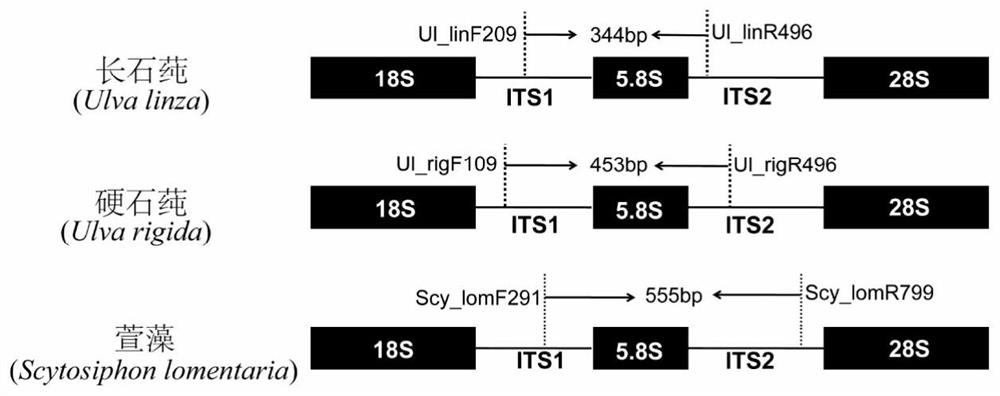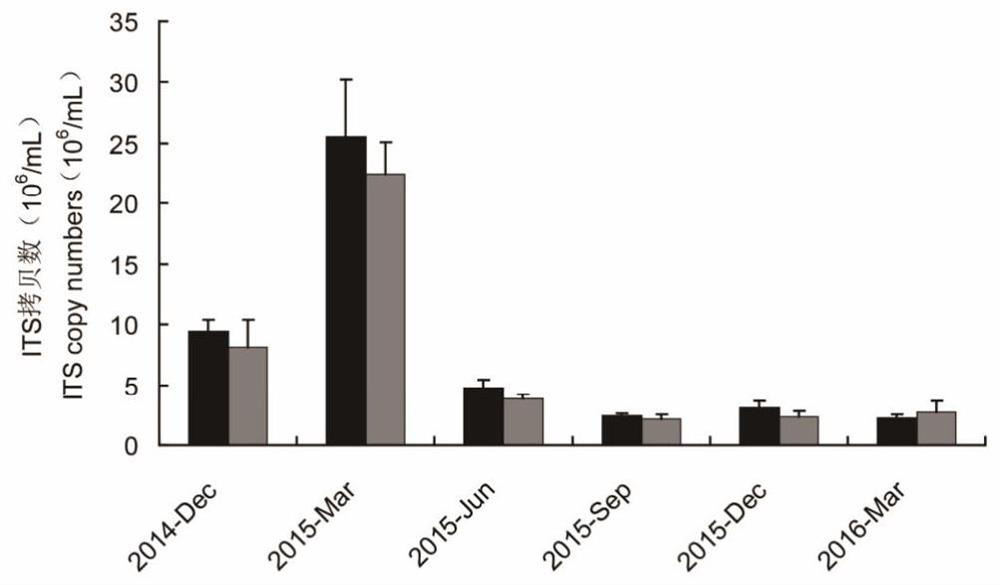A real-time quantitative PCR detection method for spores/gametes of Ulva feldspar, Ulva hard and Hemerocallis in sea cucumber culture water
A real-time quantitative technology for aquaculture water, applied in biochemical equipment and methods, microbial measurement/inspection, DNA/RNA fragments, etc., can solve the problem that it is difficult to determine the quantity or biomass, and the number of sporophytes and gametophytes of large moss algae cannot be achieved Detection and dynamic monitoring and other issues, to achieve the effect of good application potential, high sensitivity, simple and easy method
- Summary
- Abstract
- Description
- Claims
- Application Information
AI Technical Summary
Problems solved by technology
Method used
Image
Examples
Embodiment 1
[0030] Detection of algae spores / gametes in different seasons in sea cucumber culture water
[0031] The water body samples were collected from the Dongfang Ocean Sea Cucumber Breeding Base in Yunxi Village, Yantai City. After being pre-filtered through a sieve with a pore size of 200 μm, they were slowly filtered onto a cellulose acetate membrane with a pore size of 0.22 μm (diameter: 47 mm; Millipore, USA). Soil extraction kit (Mpbio, USA) was used to extract DNA.
[0032] The right end of the 18S rDNA sequence and the ITS sequence region of Ulva ulva, Ulva hardina and Hemerocallis were obtained from the Genbank database to search for species-specific primers covering part of the ITS region or the full length of the ITS region, respectively. Species of the same genus or family with a sequence similarity higher than 90% were selected as references to search for specific sites. Use the website of Intergrated DNA Technologies (http: / / sg.idtdna.com / site) to conduct online eval...
Embodiment 2
[0036] Comparison of algae spores / gametes in sea cucumber culture waters with or without moss outbreaks in the same season
[0037] The classification and identification of macroalgae, the design and verification of ITS region-specific primers, and the optimization of quantitative PCR conditions are the same as in Example 1.
[0038] Using the specific primers for the ITS region of three algae (Ulva ulva, Ulva hardina, and Hemerocarpus) and optimized quantitative PCR conditions, comparing sea cucumber culture waters in December 2014, December 2015, and March 2015 (moss outbreak) Algal spore / gamete counts between March 2016 (no moss outbreak). The results showed that the number of spores / gametes of Ulva feldspar and Ulva hardina was lower than the detection limit; in December 2014, the ITS rDNA copy number of H. 7 copy / mL, while the copy number of ITS rDNA in Hecrophyllum sp. in December 2015 was only about 3.0×10 6 copy / mL; the copy number of ITS rDNA in Hemerophyllum was as...
PUM
| Property | Measurement | Unit |
|---|---|---|
| PCR efficiency | aaaaa | aaaaa |
Abstract
Description
Claims
Application Information
 Login to View More
Login to View More - R&D
- Intellectual Property
- Life Sciences
- Materials
- Tech Scout
- Unparalleled Data Quality
- Higher Quality Content
- 60% Fewer Hallucinations
Browse by: Latest US Patents, China's latest patents, Technical Efficacy Thesaurus, Application Domain, Technology Topic, Popular Technical Reports.
© 2025 PatSnap. All rights reserved.Legal|Privacy policy|Modern Slavery Act Transparency Statement|Sitemap|About US| Contact US: help@patsnap.com



